Seagate's GoFlex Desk 4TB External HDD Review
by Anand Lal Shimpi on September 10, 2011 9:27 PM EST- Posted in
- Storage
- Seagate
- GoFlex Desk
- 4TB
I'm off to IDF this week while Ryan and Brian cover Microsoft's BUILD conference, so expect lots of CPU and Windows 8 news in the coming days. Just before I left however Seagate sent me a review sample of its recently announced GoFlex Desk 4TB drive. Eager to find out if anything had changed since I reviewed last year's 3TB model I dove right into testing.
Seagate's GoFlex Desk is a line of external 3.5" hard drives with interchangeable GoFlex Desk docks. Internally all GoFlex Desk drives have a standard Seagate 3.5" SATA hard drive; it's the GoFlex Desk dock that converts SATA into USB 3.0, USB 2.0 or FireWire 800. Since 3.5" drives require more power than you can get out of a single USB port, Seagate's GoFlex Desk requires an external power adapter that comes with the drive.
Although the SATA power and data connectors on the GoFlex Desk are in a standardized location, to date all 3rd party implementations of Seagate's GoFlex spec have been designed for 2.5" drives. As a result the only real advantage to this being a GoFlex drive is that you can swap out docks to get support for different interfaces.
By default the GoFlex Desk bundle comes with a USB 3.0 dock that's obviously backwards compatible with USB 2.0 ports. Seagate offers an optional USB 2.0/FireWire 800 dock, presumably for Mac users with FireWire 800 ports. The dock features five LEDs, one for power and the other four indicate capacity used in 25% increments.
Seagate sent me the standard 4TB USB 3.0 bundle; with it you get the drive, power adapter and a USB 3.0 cable. The drive comes preloaded with Seagate's Dashboard as well as Memeo Instant Backup. Seagate will part with a 4TB GoFlex Desk bundle for $249.
As I mentioned in our initial post on the 4TB GoFlex Desk, Seagate uses a 5-platter 7200RPM 3.5" 6Gbps SATA Barracuda hard drive inside the GoFlex Desk. At 4TB that works out to be 800GB per platter.

The spec for hard drive storage capacity is done in base 10 where 1TB = 1 trillion bytes. That works out to be 3725GiB of storage on the GoFlex Desk 4TB. We've addressed the issue with hard drives greater than 2TB in previous articles, the same discussion applies here.
A Redesigned Chassis
Despite retaining the name, the 4TB GoFlex Desk introduces a new external enclosure. It's sleeker and more angular than last year's, but more importantly it has better cooling properties. For now it looks like you can only get the new chassis if you buy the 4TB drive, the smaller capacities still ship with the old chassis.
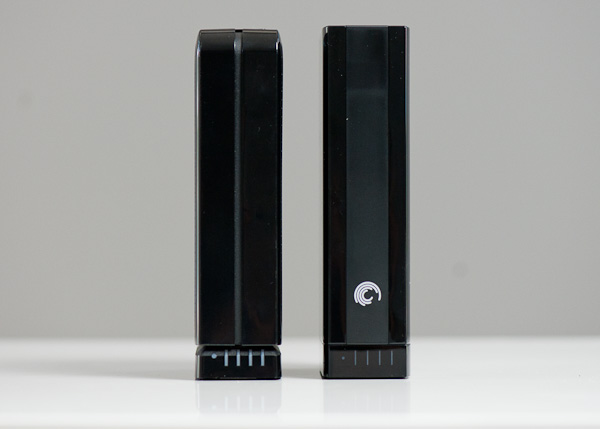
Seagate GoFlex Desk 3TB 2010 (left) vs. GoFlex Desk 4TB 2011 (right)
In our review of the 3TB GoFlex Desk we found that under hours of continued use the drive got quite warm: up to 69C. The high temperatures resulted from two things: the GoFlex Desk enclosure had very little ventilation and the 5-platter 7200RPM drive inside put out a lot of heat. With the move to 4TB Seagate stuck with a 5-platter 7200RPM design, but gave the enclosure more holes for ventilation:
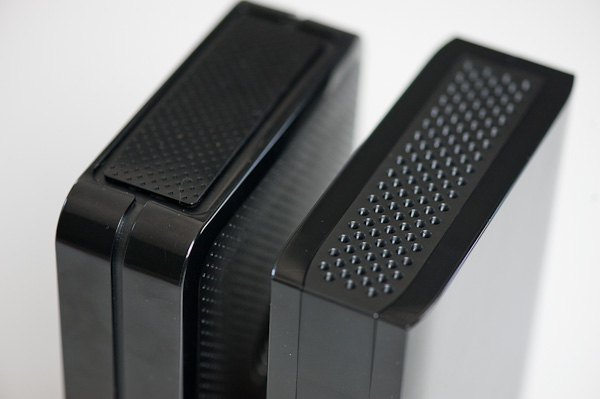
Seagate GoFlex Desk 3TB 2010 (left) vs. GoFlex Desk 4TB 2011 (right)
The top and back of the new GoFlex Desk are vented to bring down drive temperatures. The old design had dents that looked like holes but they were simply to give the plastic texture, they weren't functional. Western Digital's My Book Essential is still better ventilated but this is definitely a step in the right direction.
The new chassis definitely keeps temperatures cooler for longer under light usage, however if you're copying a lot of data to the GoFlex Desk temperatures will climb. After one hour of sequential writes over USB 3.0 I measured a drive temperature of 63C. In just under 2 hours the drive got up to 67C, a bit lower than last year's model but still troubling. The good news is unlike last year's model, the drive will continue to operate at full performance in this state. When testing the 3TB version last year we found that sequential write speeds dropped to 50MB/s when the temperature got into the upper 60s.
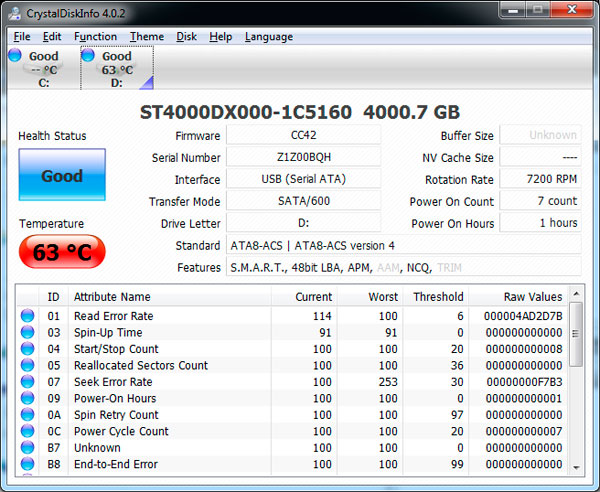
Granted that's after copying nearly 1TB of data without pause, so you shouldn't see these numbers other than the very first time you copy all of your data to the drive. During normal use and even when moving around a couple hundred GB of data the 4TB GoFlex Desk kept to 51C and below. I'm happy to see that Seagate redesigned the chassis, but I'd still feel more comfortable with even more ventilation or at least a cooler running drive inside.
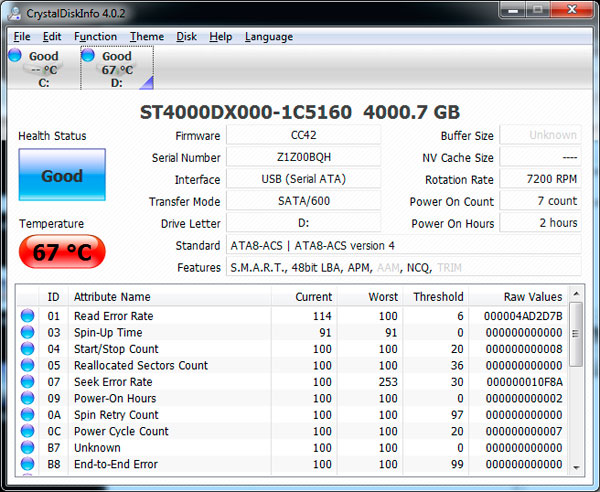
The internal Barracuda + USB 3.0 dock consume 11.9W at idle and 13.7W under load. The drive whine is audible when on but it's not overly loud. If you're using anything other than a very quiet notebook you'll likely not be too bothered by the drive.


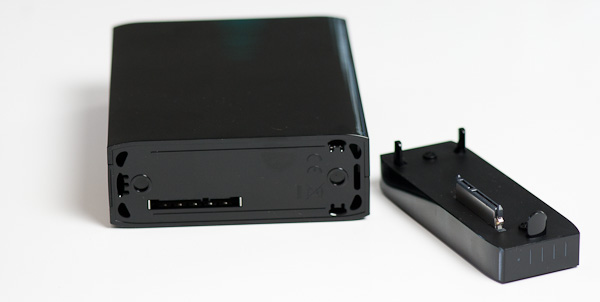
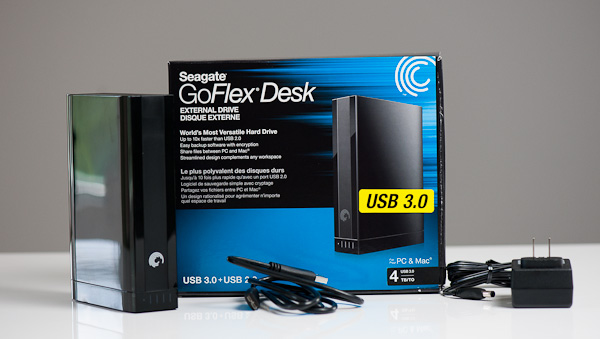






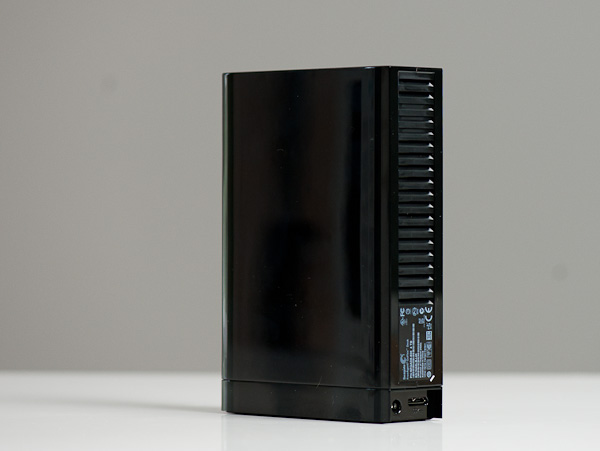








34 Comments
View All Comments
Mitch89 - Saturday, September 10, 2011 - link
The swappable interfaces is an interesting idea, but wouldn't it just make sense to make it FW800/USB3 standard, instead of messing about with different adaptors?dagamer34 - Sunday, September 11, 2011 - link
It's not hard to imagine a Thunderbolt adapter. FW800/USB3 are great but they have their disadvantages. Same with eSATA.FW800 - slow, hard drive is faster than the bus.
USB 3.0 - while fast, it requires traveling over the USB protocol, which is at the mercy of the quality of your USB 3.0 controller.
eSATA - fine for desktops, but may not be present on laptops.
Thunderbolt - can be part of a daisy chain, which reduces the number of wires coming out of a laptop.
Guspaz - Monday, September 12, 2011 - link
On the contrary, eSATA is far more common on laptops than desktops (although it's simple to add to desktops with cheap adapters); eSATAp ports (hybrid USB/eSATA ports that can provide power) are very common on laptops these days.While a thunderbolt adapter for the GoFlex drives might be convenient, it's not going to get you any performance over eSATA; the GoFlex drives basically just provide a mechanical standard that lets the adapter plug right into the drive's SATA port via modified eSATA. This means that an eSATA adapter for the GoFlex is entirely passive (being the native format of the drive), while a Thunderbolt adapter is going to be active. At that point, the real question is, which controller will be better; your laptop/desktop's SATA controller, or Seagate's Thunderbolt controller (which will be doing the same thing, SATA-to-PCIe)?
Jaybus - Wednesday, September 14, 2011 - link
USB 3 can also connect to a hub. I think the author is far too quick to blame USB 3 for the performance issue with the last TB of the drive. I can think of no reason why the USB 3 controller should know or care which tracks of the drive the read heads happen to be over. I disagree with the author's assumption that the USB 3 controller is to blame. We can't know for sure, because it was deemed that USB 2 testing was not needed and neither was the drive removed from the case and tested in native SATA.seapeople - Wednesday, September 14, 2011 - link
He's not blaming USB 3.0 for the low performance at the end of the drive, he's blaming it for bottlenecking the performance at the beginning of the drive. The write speed should decrease linearly as the drive fills up due to the physics of data storage on a rotating platter, but the fact that it doesn't decrease for 3TB means something is limiting the drive's performance.sheh - Saturday, September 10, 2011 - link
I'm guessing Firewire is for the Apple people?logic_88 - Saturday, September 10, 2011 - link
What's the advantage of GoFlex over something like a SATA dock? I have a couple of triple interface SATA docks (USB2, eSATA, FW400) and it's easy to swap bare SATA drives whenever I want more/different storage.TypeS - Sunday, September 11, 2011 - link
Are you really asking that question? The GoFlex is not a dock, it is a packaged external drive with changeable interfaces. A a dock is a dock, a stationary device/tool.logic_88 - Sunday, September 11, 2011 - link
Since the GoFlex has a power brick, I don't see how it's any more portable than my dock.enderwiggin21 - Monday, September 12, 2011 - link
Fair enough, but essentially what you're asking is what's the point of ANY external drive when you can just use a dock. The answers to that shouldn't be too hard to figure out. Off the top of my head:Heat dissipation. Bare drives in my dock always run about 10 degrees cooler than drives I use that are actively cooled or have heatsinks attached to them.
Noise.
Protection.
And Dock + Power Cable + Drive + Cables = at least 1 more item to carry around than any external drive.